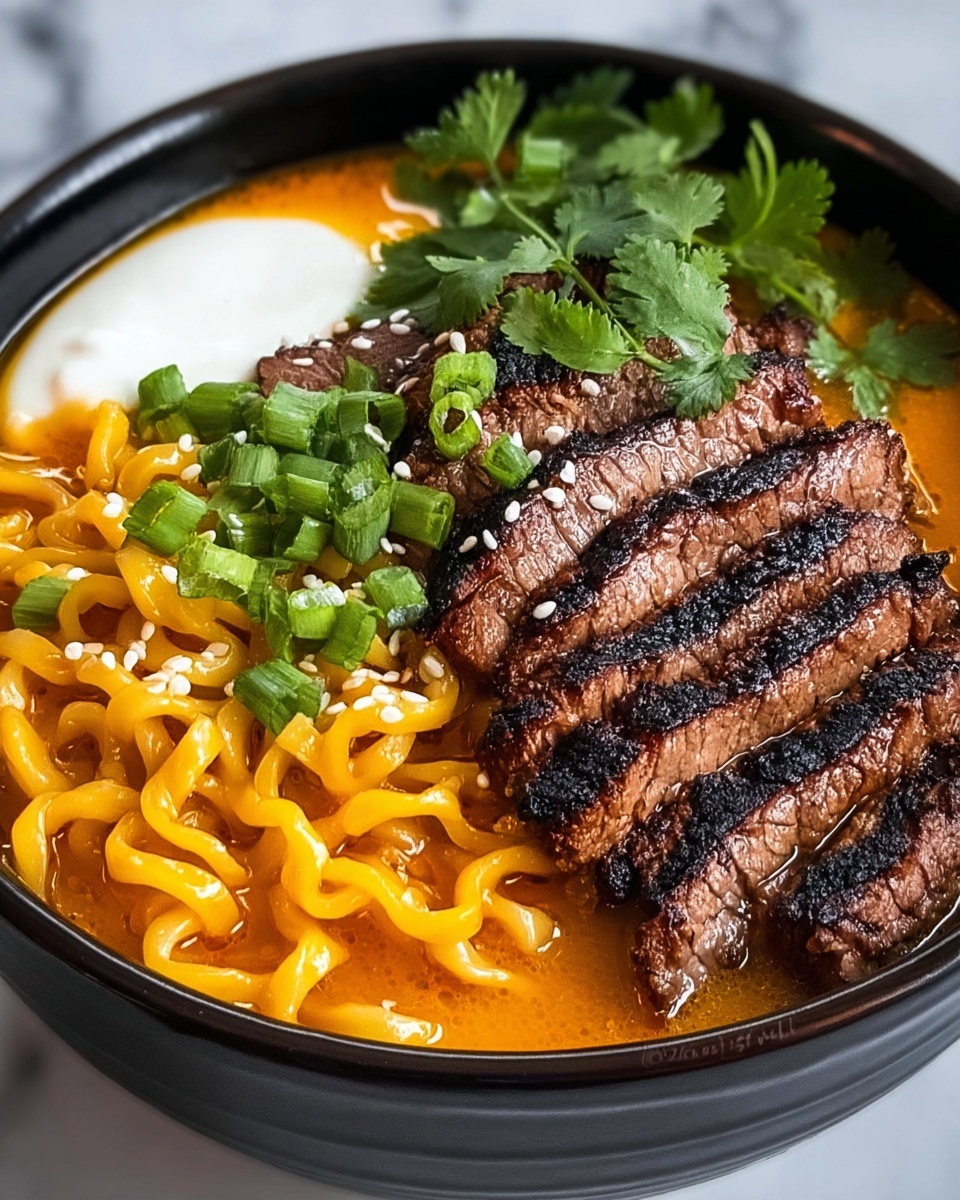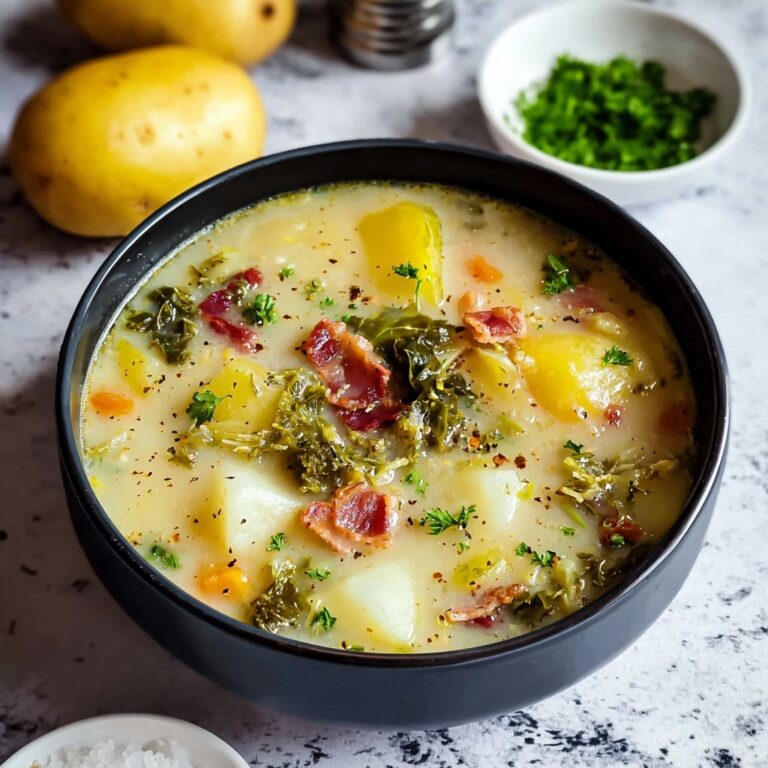If you are craving a bowl of comforting, bold, and satisfyingly spicy noodles, you have to try this Spicy Korean Ramen Beef Recipe. It brings together tender slices of marinated beef, vibrant vegetables, and the perfect kick of Korean chili paste and flakes, all swimming in a savory, soul-soothing broth. This dish manages to be both incredibly easy to make and explosively flavorful, making it an absolute weeknight hero that will quickly become a favorite in your kitchen.
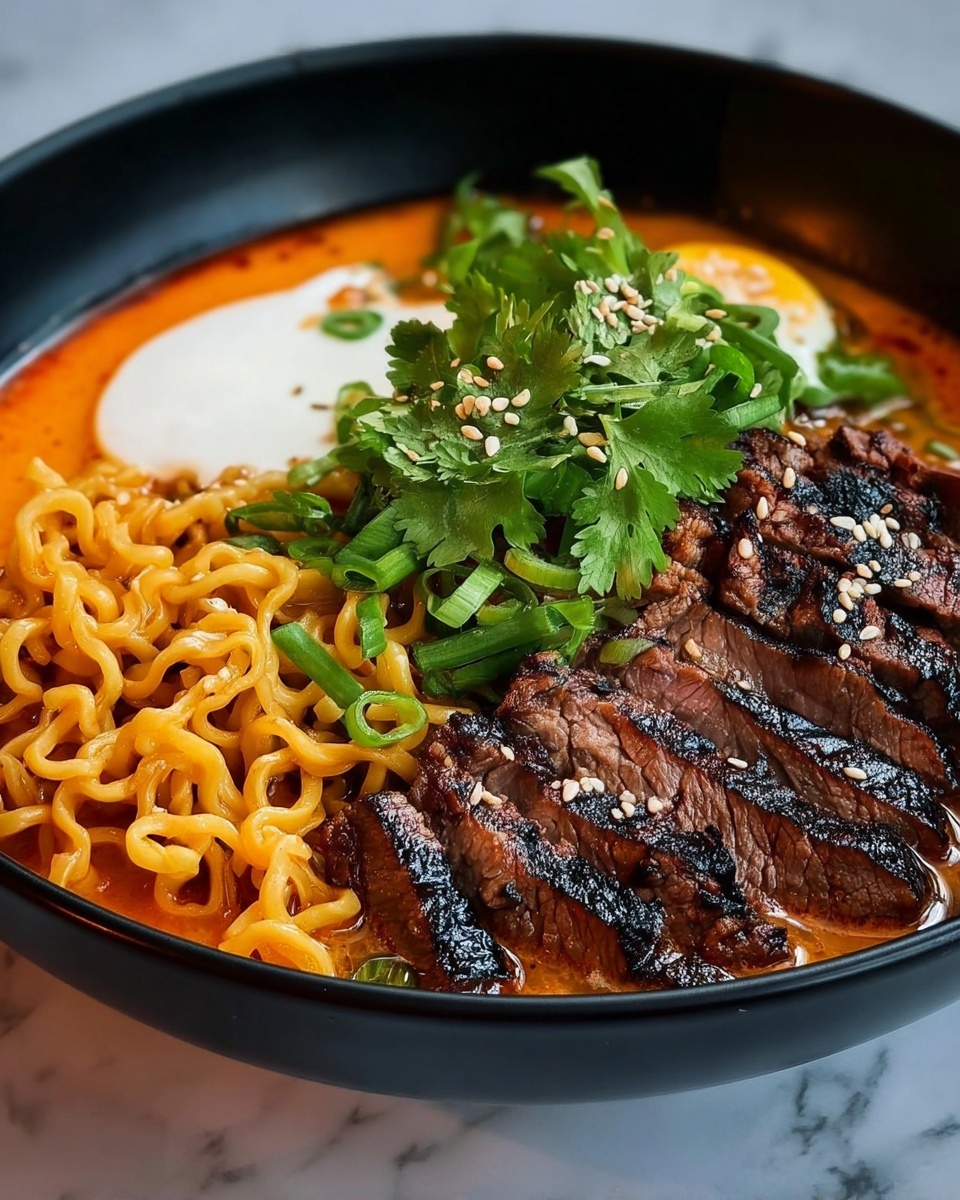
Ingredients You’ll Need
The magic of this Spicy Korean Ramen Beef Recipe lies in its thoughtfully simple ingredients. Each one plays a unique role in building layers of flavor, texture, and color—from the tender beef to the spicy gochujang, to the crisp, fresh vegetables that bring brightness and contrast.
- 4 packets instant ramen noodles (Korean Shin Ramyun recommended for spice): These provide the perfect chewy texture and a spicy base when cooked in the broth.
- 8 cups water: The foundation for your broth that brings everything together.
- 1 pound beef sirloin, thinly sliced against the grain: Tender, juicy beef that soaks up all the wonderful flavors.
- 2 tablespoons soy sauce: Adds deep umami and a slight saltiness to the beef marinade and broth.
- 1 tablespoon sesame oil: Gives a nutty richness that balances the spicy notes.
- 1 tablespoon gochujang (Korean chili paste): The signature spicy, slightly sweet, and fermented kick that defines this dish.
- 1 teaspoon minced garlic: Boosts the aromatic depth that makes the recipe so irresistible.
- 1/2 teaspoon ground ginger: Adds warmth and a subtle zing to the marinade.
- 1/4 teaspoon black pepper: Enhances the overall complexity without overpowering.
- 1 tablespoon vegetable oil: For sautéing the vegetables and beef to perfection.
- 1 medium onion, thinly sliced: Sweetness and body to the dish’s texture.
- 2 cloves garlic, minced: Fresh garlic aroma that builds on the marinated beef’s flavor.
- 1 red bell pepper, thinly sliced: Vibrant color and subtle sweetness.
- 1 green bell pepper, thinly sliced: Adds crunch and a fresh peppery note.
- 4 ounces mushrooms, sliced (shiitake, cremini, or button): Earthiness and meaty texture to complement the beef.
- 2 green onions, thinly sliced, for garnish: Bright and sharp finishing touch.
- 1 cup bean sprouts: Adds crunch and freshness right before serving.
- 1/2 cup kimchi, chopped (optional, for extra spice and flavor): Boosts the tang and depth if you’re craving more heat and complexity.
- 2 tablespoons soy sauce: Additional seasoning for the broth’s perfect balance.
- 1 tablespoon gochugaru (Korean chili flakes, adjust to taste): Elevates the heat and vibrant red color.
- 1 teaspoon sugar: Balances out the spiciness and acidity.
- 1 teaspoon fish sauce (optional, for umami): Adds a subtle, savory punch.
- 2 soft-boiled eggs, halved: Creamy, rich topping that takes the dish over the top.
- Sesame seeds, for garnish: Tiny bursts of nuttiness and added texture.
- Nori seaweed sheets, cut into strips: An authentic note of the sea and an elegant finish.
How to Make Spicy Korean Ramen Beef Recipe
Step 1: Marinate the Beef
Start by mixing your thinly sliced beef sirloin with soy sauce, sesame oil, gochujang, minced garlic, ground ginger, and black pepper. This marinade infuses the beef with bold, spicy, and aromatic flavors, making it irresistibly tender and flavorful. Let it rest for at least 15 minutes to really absorb the marinade; if you have more time, 30 minutes in the fridge is even better.
Step 2: Sauté the Vegetables and Beef
Heat vegetable oil in your pot and soften the sliced onions until they turn translucent and sweet, which takes about 3–5 minutes. Toss in fresh minced garlic and cook until fragrant. Now add your marinated beef and sear it until it’s beautifully browned on all sides. Stir in the red and green bell peppers and mushrooms and cook until the vegetables are tender-crisp. If you’re using kimchi, add it now for an extra punch of flavor, cooking it briefly with everything to blend those layers.
Step 3: Cook the Ramen and Enhance the Broth
Pour in 8 cups of water and bring everything to a rolling boil. Toss in the ramen noodles and cook according to the package directions, usually around 3 to 5 minutes. While the noodles swim in this rich broth, stir in soy sauce, gochugaru, sugar, and fish sauce. These ingredients balance heat, saltiness, sweetness, and umami, creating a deep, unforgettable broth. Remember to add bean sprouts during the last minute for fresh crunch.
Step 4: Assemble and Serve
Divide the ramen, beef, vegetables, and broth evenly into bowls. Garnish generously with sliced green onions and a sprinkle of sesame seeds. For a classic, beautiful touch, place a soft-boiled egg half on top and add nori strips for that authentic Korean flair. Serve it up piping hot, and get ready for an amazing meal.
How to Serve Spicy Korean Ramen Beef Recipe
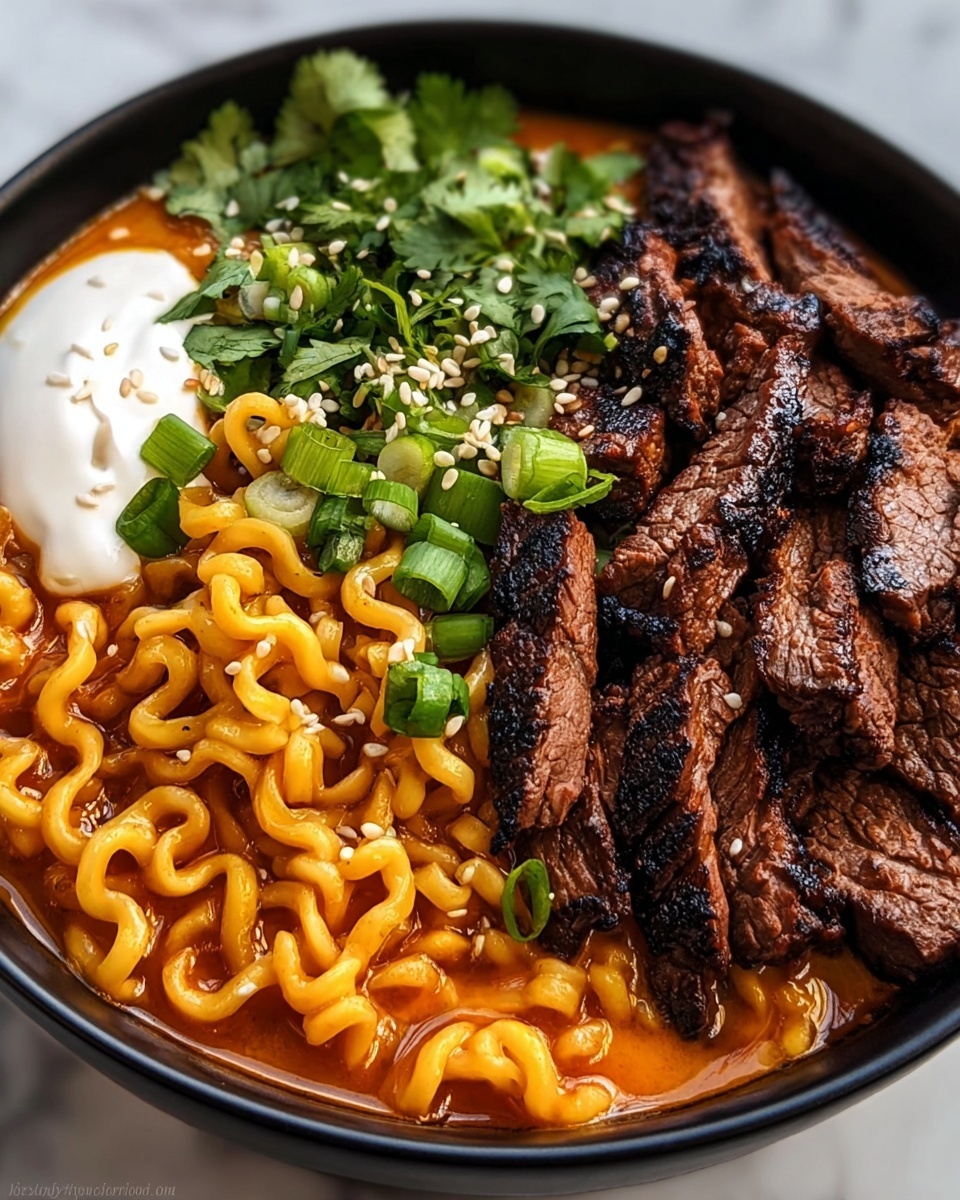
Garnishes
Green onions and sesame seeds are your best friends here, scattered on top for bursts of fresh crunch and toasty flavor. Adding soft-boiled eggs not only amps up the richness but also gives you that indulgent, silky yolk that blends with the spicy broth. Nori seaweed strips add texture, a subtle oceanic note, and helped me feel like I was eating right at my favorite Korean spot.
Side Dishes
This Spicy Korean Ramen Beef Recipe is quite hearty on its own, but pairing it with simple sides makes the meal even more memorable. A crisp cucumber salad or a small bowl of steamed rice complements the spicy broth beautifully. You can also serve it with some extra kimchi on the side to add contrasting tartness and crunch.
Creative Ways to Present
For a fun twist, try layering your bowl with a bed of sautéed spinach or bok choy before ladling the broth and noodles. You could also customize it by topping with crispy fried shallots or a drizzle of chili oil to boost the heat profile. If entertaining, setting out a variety of toppings like chopped peanuts, lime wedges, or fresh herbs allows everyone to personalize their bowl.
Make Ahead and Storage
Storing Leftovers
Once cooled, transfer any leftover Spicy Korean Ramen Beef to an airtight container and refrigerate for up to 3 days. Keep the noodles and broth together as the noodles will absorb the flavors overnight, making them even more delicious but slightly softer.
Freezing
This recipe freezes best if you separate the broth with beef and vegetables from the noodles. Freeze the broth in individual containers for up to 2 months. When ready to enjoy, thaw completely before reheating gently on the stovetop.
Reheating
To reheat, warm the broth with beef and vegetables on medium heat until just simmering. Add freshly cooked or leftover noodles, warming them briefly to prevent them from overcooking. Avoid the microwave when possible to maintain the broth’s delicate flavor and the beef’s texture. Top with fresh garnishes to revive that fresh, vibrant finish.
FAQs
Can I use a different type of beef?
Absolutely! While sirloin is tender and flavorful, flank steak or ribeye thinly sliced would also work wonderfully in this recipe, offering slightly different textures but just as delicious results.
How spicy is this Spicy Korean Ramen Beef Recipe?
It has a lively level of heat thanks to gochujang and gochugaru, but you can always adjust the amount of chili paste and flakes to tailor it to your personal spice tolerance without losing the distinct Korean flavor.
Can I make this recipe vegetarian?
You can substitute the beef for extra mushrooms, tofu, or even a medley of hearty vegetables. Use vegetable broth and skip the fish sauce to keep it vegetarian-friendly without sacrificing flavor.
What’s the best way to cook the soft-boiled eggs?
Bring water to a boil, gently add eggs, and cook for exactly 7 minutes for that perfect jammy yolk. Cool them quickly in ice water to stop the cooking process and make peeling easier.
Is kimchi necessary in this recipe?
Kimchi adds an extra layer of flavor and heat and is optional. If you love that tangy, fermented bite, it’s worth adding. Otherwise, the dish is delicious without it, keeping the focus on the beef and spicy broth.
Final Thoughts
This Spicy Korean Ramen Beef Recipe is a shining example of how simple ingredients and straightforward steps can come together to make an extraordinary meal. It’s a bowl filled with warmth, spice, and richness that comforts like a hug on a chilly evening. I wholeheartedly encourage you to dive in, get a little saucy with the marinade, and enjoy every slurp of this delicious, hearty dish. You’ll find yourself coming back to it again and again.
Print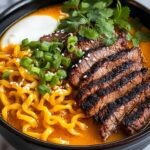
Spicy Korean Ramen Beef Recipe
- Prep Time: 20 minutes
- Cook Time: 20 minutes
- Total Time: 40 minutes
- Yield: 4 servings
- Category: Main Dish
- Method: Stovetop
- Cuisine: Korean
Description
This Spicy Korean Ramen Beef recipe combines tender marinated beef sirloin with vibrant vegetables and flavorful Korean spices in a hearty, comforting bowl of ramen. Using Korean Shin Ramyun noodles and a spicy broth enhanced with gochujang, gochugaru, and optional kimchi, this dish delivers authentic Korean flavors in an easy one-pot meal perfect for weeknights. The addition of soft-boiled eggs, sesame seeds, and nori strips adds texture and richness to complete this delicious and satisfying ramen experience.
Ingredients
Beef Marinade
- 1 pound beef sirloin, thinly sliced against the grain
- 2 tablespoons soy sauce
- 1 tablespoon sesame oil
- 1 tablespoon gochujang (Korean chili paste)
- 1 teaspoon minced garlic
- 1/2 teaspoon ground ginger
- 1/4 teaspoon black pepper
Main Ingredients
- 4 packets instant ramen noodles (Korean Shin Ramyun recommended for spice)
- 8 cups water
- 1 tablespoon vegetable oil
- 1 medium onion, thinly sliced
- 2 cloves garlic, minced
- 1 red bell pepper, thinly sliced
- 1 green bell pepper, thinly sliced
- 4 ounces mushrooms, sliced (shiitake, cremini, or button)
- 1 cup bean sprouts
- 1/2 cup kimchi, chopped (optional)
Broth Enhancements and Garnishes
- 2 tablespoons soy sauce
- 1 tablespoon gochugaru (Korean chili flakes, adjust to taste)
- 1 teaspoon sugar
- 1 teaspoon fish sauce (optional)
- 2 soft-boiled eggs, halved
- 2 green onions, thinly sliced, for garnish
- Sesame seeds, for garnish
- Nori seaweed sheets, cut into strips
Instructions
- Preparing the Beef: In a medium bowl, combine the thinly sliced beef sirloin with soy sauce, sesame oil, gochujang, minced garlic, ground ginger, and black pepper. Mix well to evenly coat the beef. Let it marinate for at least 15 minutes or up to 30 minutes in the refrigerator to enhance flavor.
- Sautéing the Vegetables and Beef: Heat vegetable oil in a large pot or Dutch oven over medium-high heat. Add the sliced onion and cook for 3-5 minutes until softened and translucent. Stir in minced garlic and cook for another minute until fragrant. Add the marinated beef and cook for 5-7 minutes, browning on all sides. Then add the sliced red and green bell peppers and mushrooms. Cook for 3-5 minutes until vegetables are tender-crisp. If using kimchi, add it now and cook for an additional minute, stirring to combine.
- Cooking the Ramen and Enhancing the Broth: Pour 8 cups of water into the pot with the sautéed beef and vegetables and bring to a boil. Once boiling, add the ramen noodles and cook according to package instructions, usually 3-5 minutes. While noodles cook, stir in soy sauce, gochugaru, sugar, and fish sauce (if using) to the broth. Mix well to dissolve the sugar. Taste and adjust seasoning as desired. Add bean sprouts during the last minute of cooking.
- Assembling and Serving: Divide the cooked ramen noodles, beef, vegetables, and broth evenly among four bowls. Garnish each with sliced green onions, sesame seeds, and halved soft-boiled eggs. Add strips of nori seaweed if desired. Serve immediately and enjoy the spicy, flavorful Korean ramen beef.
Notes
- Adjust the amount of gochujang and gochugaru to control spice level according to taste preference.
- You can substitute beef sirloin with ribeye or flank steak for different textures.
- Soft-boiled eggs add richness but can be omitted for a lighter dish.
- Use Korean Shin Ramyun noodles for authentic spicy flavor; other instant noodles can be used but may alter taste.
- Kimchi is optional but adds extra depth and spice to the broth.

